|
Case
study 2
The first decade
in the life of the Kingdom of Serbs,
Croats and Slovenians ended in
bloodshed: on June 20, 1928
Radicals’ MP of the parliamentary
majority Puriša Račić gunned down
two MPs of the Croatian Peasant
Party /HSS/ (Dr. Đuro Basariček and
Pavle Radić), wounded two (Dr. Ivan
Pernar and Josip Granđa), while the
fifth, the party leader (Stjepan
Radić) succumbed to his wounds a few
days later. Four out of the five
were in the leadership of HSS (the
Croatian Republican Peasant Party
till 1925) the indisputable
political representative of the
Croat people on the account of
parliamentary seats won in all
earlier elections. The consequences
of the shooting were both immediate
and far-reaching. The former became
evident in almost no time:
pseudo-parliamentarianism collapsed
to be replaced by overt dictatorship
of King Alexander (January 6, 1929).
Reactions to the crime, especially
by foreign press, hinted at the
latter. By the way the crime was
committed in – the way that must
have humiliated the entire Croat
nation – foreign commentators only
logically predicted new tensions in
the Kingdom.1
Historiographic
writings in various centers of the
Kindgom and, later on, of the
Republic of Yugoslavia have not
ignored the factographic side of the
crime the scene of which was the
People’s Assembly. And yet, Croatian
authors were those who occupied
themselves with it the most.2 Many of
them were publishing integrally the
transcripts taken at the People’s
Assembly’s sessions discussing the
crime as prime historical source.3
Some were explaining they were doing
it “to venerate the memory of the
victims.”4 True, no interpretation
could replace the authenticity of
the above-mentioned transcripts. But
by quoting only, these historians
were freeing themselves of the
obligation to discern the motive
from the long history of crime, from
its essence.
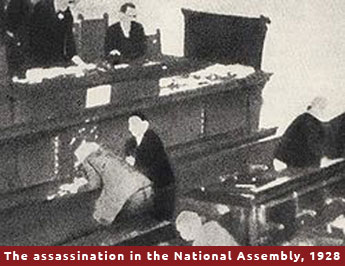 The WWII when so
much to what the Kindgom’s instable
peace had paved the way to,
subsequent rebuilding of Yugoslavia
and the new order placed in the back
seat not only the interest in the
bloodshed in the People’s Assembly
but in the Kindgom itself. However,
conditions for the renewal of that
interest were being created in
1960th and 1970th. Historical
distance was there, and
contemporaries of the events
silenced by circumstances up to then
were still alive. Many had written
memoires while in emigration and
began publishing them (V. Maček, I.
Meštrović, S. Pribićević, M.
Stojadinović, etc.). However,
crucial was the renewal of “old”
controversies, especially about the
character of the common state, a
deep-rooted controversy considering
constant constitutional amendements.
Feeling freer to research historians
began turning their attention to the
causality of the events from recent
and not so recent past. And so the
turn came to the bloodshed in the
People’s Assembly: the incident that
had lethally spurred “separatist
currents, especially at the time of
Yugoslavia’s occupation in
1941–1945.“ And so the context came
under scrutiny. “Račić’s shooting,
resulting from the unsettled
controversies permeating the entire
public sphere of old Yugoslavia at
the time, was a culmination of
political tensions and conflicts
between the official centralism and
oppositionist anti-centralism.”5 The WWII when so
much to what the Kindgom’s instable
peace had paved the way to,
subsequent rebuilding of Yugoslavia
and the new order placed in the back
seat not only the interest in the
bloodshed in the People’s Assembly
but in the Kindgom itself. However,
conditions for the renewal of that
interest were being created in
1960th and 1970th. Historical
distance was there, and
contemporaries of the events
silenced by circumstances up to then
were still alive. Many had written
memoires while in emigration and
began publishing them (V. Maček, I.
Meštrović, S. Pribićević, M.
Stojadinović, etc.). However,
crucial was the renewal of “old”
controversies, especially about the
character of the common state, a
deep-rooted controversy considering
constant constitutional amendements.
Feeling freer to research historians
began turning their attention to the
causality of the events from recent
and not so recent past. And so the
turn came to the bloodshed in the
People’s Assembly: the incident that
had lethally spurred “separatist
currents, especially at the time of
Yugoslavia’s occupation in
1941–1945.“ And so the context came
under scrutiny. “Račić’s shooting,
resulting from the unsettled
controversies permeating the entire
public sphere of old Yugoslavia at
the time, was a culmination of
political tensions and conflicts
between the official centralism and
oppositionist anti-centralism.”5
A study of the
incident itself, detailed inansumuch
as scrupulous, belongs to the period
of grown interest in the bloodshed
taking place in the People’s
Assembly.6 It is the more so worthy
as its author has found witnesses
and gave them floor. The latter were
very old, “with one foot in the
grave,” and the historian was by far
more interested in their reflections
about complexities of Yugoslavia’s
history and their causality than in
details witnesses remembered. These
reflections were not a fruit of some
historical theory but of human
desire for truth and justice
knowledge can help to reach.7
The ideal way to
come to historical explanation of
the crime committed in the People’s
Assembly on June 20, 1928 is
comparable to exploring with a probe
the insides of the entire state and
society, the structure of their
mentality and political culture; and
the illegal sphere with its secret
organizations such as King
Alexander’s “White Hand” /Bela Ruka/
in the Army.8
Despite all the
difficulties of exploration
comparable to a probe, unmistakable
dots remain in full view and, once
connected into a single line, lead
towards a relevant conclusion about
the causes and consequences of the
crime. It is a historian’s duty to
draw that line. This is why quoting
authentic historical sources such as
transcripts taken in the People’s
Assembly are not good enough.
St. Vitus Day Constitution declared;
political tensions grow;
attempt at reaching compromise; the
strategy changed
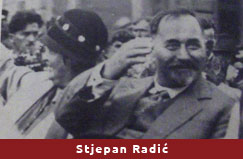 Declaration of the
St. Vitus Day Constitution failed to
relax the situation in the country.
On the contrary, the gap between
centralists and anti-centralists
grew deeper and deeper. Stjepan
Radić announced he recognized not
the Constitution and not without a
good reason. Four of Croatia’s
parties formed the Croatian bloc
that had the support of the majority
of Croat population. Declaration of the
St. Vitus Day Constitution failed to
relax the situation in the country.
On the contrary, the gap between
centralists and anti-centralists
grew deeper and deeper. Stjepan
Radić announced he recognized not
the Constitution and not without a
good reason. Four of Croatia’s
parties formed the Croatian bloc
that had the support of the majority
of Croat population.
Soon after the
Constitution was declared in
Belgrade (August 10, 1921) King
Peter I died. The Zagreb
municipality refused to send a
delegation to his funeral; and the
government, therefore, dismissed its
management. Stjepan Radić was
elected the prefect in the elections
that ensued – a testimony of HRSS’s
repute not only in the countryside
but in the city as well. And yet,
the trench warfare was not over: the
government sent its commissioner to
Zagreb.
To draw Europe’s
attention to the “Croatian question”
the Croat bloc addressed a
memorandum to the International
Conference in Genoa.9 The entire
Kingdom was in turmoil. In late 1922
the Radical Party formed the
government. As early as in March
that followed it called the
elections for August 18, 1923.
During the election campaign the
Radical Party was settling accounts
with the Democratic Party accusing
the latter of its readiness to reach
an agreement with Croats.
HRSS triumphed in
the elections but continued
boycotting the People’s Assembly.
How to overcome the impasse? HRSS
and the Democratic Party were trying
to find a way out. Initiated by HRSS
the talks with the Radicals were
first held in Belgrade (in early
April 1924) and then in Zagreb. They
resulted in the Zagreb or Marko’s
protocol10 that paved the way to the
agreement. But the Radicals treated
the document like they had the Corfu
Declaration: that is no agreement at
all, they claimed, but just a memo.
In a public address (June 7, 1923)
Pašić started distancing himself
from it.
Embittered by
Pašić’s disloyalty, Radić told the
HRSS convention commemorating the
anniversary of the French Revolution
(July 14, 1924) that Croatia was a
prisoner of “the Serbian Bastille.”
Another of his statements was seen
as an insult to the King and the
Queen. The procedure for depriving
him of MP immunity and putting to
trial was launched. To avoid such a
scenario and with a helping hand
from his associates Radić went
abroad undercover. From Vienna he
made towards Paris and London
advocating with European governments
for the “Croatian question.” His
mission failed: his interlocutors
were only interested in stability of
the Balkans and the East
Mediterranean. In other words, they
were concerned with the survival of
the Kingdom of SHS at any price,
including Serbia’s domination over
smaller nations making it.
During his tour of
Europe Radić was invited by Soviet
Foreign Minister G.V. Chicherin to
visit Moscow. Once there, he
enrolled his party in the membership
of the Peasant International, a part
of the Third International
(Komintern). At home, the news about
it was seen as high treason.
A year later Radić
returned to the country. He was
arrested on January 5, 1925. He was
charged with a crime punisheable
with ten-year imprisonment and a ban
on his party. And then, strategies
were changed: both by
anti-centralists and centralists.
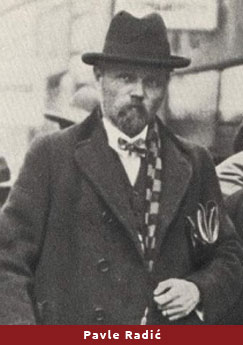 Elections were
called for February 8, 1925. HRSS
won 67 seats, while Stjepan Radić
triumphed in three electoral
districts though from prison. And
against the background of high
tensions he decided to take yet
another risky step that was
subsequently labeled capitulation, a
political maneuver or a new
strategy. In the People’s Assembly
(March 27, 1925) his nephew Pavle
Radić, the HRSS politician people
trusted the most, read out a
statement by his party’s leadership
– the statement that rounds off the
period from 1918 to 1925. Elections were
called for February 8, 1925. HRSS
won 67 seats, while Stjepan Radić
triumphed in three electoral
districts though from prison. And
against the background of high
tensions he decided to take yet
another risky step that was
subsequently labeled capitulation, a
political maneuver or a new
strategy. In the People’s Assembly
(March 27, 1925) his nephew Pavle
Radić, the HRSS politician people
trusted the most, read out a
statement by his party’s leadership
– the statement that rounds off the
period from 1918 to 1925.
Writings about the
history of the Kingdom of SHS
usually quote the passage of the
statement that, at the time, turned
the wheel of history:
“We acknowledge
the overall political situation as
it is today by the St. Vitus Day
Constitution and with the
Karađorđević dynasty at the throne.”11
However, the
statement has many meanings.
Pragmatic as it was, though not out
of fear or in the attempt to have
his leader released from prison,
HRSS – or HSS – practically set the
foundation for its activity in the
times to come:
“We want to be
politically equal, like Croats,
Serbs and Slovenians are, being
three equal brothers. If we make up
the same people, we hear them
saying, it makes no difference
whether a Serb or a Croat is in some
office, and then, when all the
offices are occupied by Serbs, again
we hear them saying, it’s all the
same.
“If in this
country, it’s not all the same to
us. We do not want to be here
quantité négligeable (the quantity
that can be neglected). We want our
share here, we want to be among the
creators of this state…We want to be
equal in decision-making since our
people, thank Heaven, are
politically too mature to be treated
as second rate citizens or to have a
status as such…”12
Recognizing the
factual state of affairs – the St.
Vitus Day Constitution – the
statement quotes at the same time,
“To amend these facts and the state
of affairs our will and conscience
cannot possibly approve of, the
Constitution, the said popular
agreement between Serbian, Croat and
Slovenian peoples should be
revised.”13
Was the Court
really sure that it has finally
subjugated Croats? It continued
putting them to the test by
appointing them ministers, Stjepan
Radić included. As for Radić, he
turned to the struggle against
corruption the center of which was
the Court. “The people in the King’s
circle belong more behind the bars
than in the Court.”14 With a policy as
such Radić was finding an echo among
the peasantry in Serbia and
Macedonia. And that was threatening
indeed; his activism triggered off
the idea about his liquidation, the
more so after he formed, with his
once opponent Svetozar Pribićević,
the Peasant Democratic Coalition.
Last elections
before January 6 Dictatorship were
held on September 11, 1927. The
already quoted Dragoljub Jovanović
compared the country to a mental
asylum. And it was in 1928, at the
time of Velja Vukićević’s
premiership, that the idea about
Radić’s liquidation – born in Serbia
earlier15 - became “legitimate.”
Vukićević, the secondary school
teacher with no political authority
and reputation, was King Alexander’s
man. In his newspaper “Jedinstvo”
/Unity/ he was openly calling for
the murder of Stjepan Radić.
Assassination of Stjepan Radić and
his associates prepared
Preparations for
for the murder of Stjepan Radić and
his associates in the People’s
Assembly on June 20, 1928 (a precise
gun was procured, Stjepan Radić
himself prevented from attending a
conference of the Interparliamentary
Union so as to ensure his presence
in Belgrade on June 20; and sessions
of the parliament were chaired
contrary to the relevant procedure
Dr. Ninko Perić, the chair and law
professor, must have been well aware
of) have been examined in detail in
Croatia’s historiography.16 This leads
to the conclusion other historians
share with their Croat colleagues
that the assassination had been
contracted and organized, executed
impassively and in cold blood, while
executioners felt safe. The
executioners were known, the small
circle of their accomplices, too. As
for those who ordered it, all the
leads pointed toward the Court – or
to King Alexander. But like in all
political murders demonstrative
evidence was missing for the simple
reason that such traces are never
left behind.
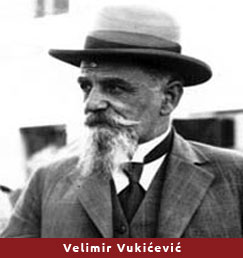 The atmosphere
creating psychological and political
climate for the murder was examined
in particular detail – the manner in
which the public in Serbia had been
prepared for all earlier political
murders.17 The word already had it.
People in many places were telling
one another, “Radić is killed!” Then
the very term murder became
frequent. With his anti-Yugoslav
editorial policy Milan Gavrilović,
the editor-in-chief of the Politika
daily, was brewing bad blood between
Serbs and Croats. And “Jedinstvo,”
the above-mentioned mouthpiece of
Prime Minister Velja Vukićević, who
was financing it from disposition
funds under his control, was openly
threatening the leaders of the
Peasant Democratic Coalition Stjepan
Radić and Svetozar Pribićević with
murder. The atmosphere
creating psychological and political
climate for the murder was examined
in particular detail – the manner in
which the public in Serbia had been
prepared for all earlier political
murders.17 The word already had it.
People in many places were telling
one another, “Radić is killed!” Then
the very term murder became
frequent. With his anti-Yugoslav
editorial policy Milan Gavrilović,
the editor-in-chief of the Politika
daily, was brewing bad blood between
Serbs and Croats. And “Jedinstvo,”
the above-mentioned mouthpiece of
Prime Minister Velja Vukićević, who
was financing it from disposition
funds under his control, was openly
threatening the leaders of the
Peasant Democratic Coalition Stjepan
Radić and Svetozar Pribićević with
murder.
The paper’s
insolence was also to be ascribed to
the trap the cabinet found itself
in. The parliament had the Neptune
Conventions with Italy on agenda.
The Conventions were not in the
country’s interests in Dalmatia,
Croatian Coastland and islands.
Croats were especially embittered by
them. In Belgrade (May 31, 1928)
people were protesting under the
slogans, “Down with fascism!” “Down
with Mussolini!” “Long live
Dalmatia!” and “Long live the
Yugoslav Rijeka!” Gendarmes
intervened brutally hurting a number
of citizens. The opposition called
for a parliamentary debate on the
incident and the cabinet’s
resignation.
Two weeks before
the bloodshed in the People’s
Assembly (June 14, 1928) Vukićević’s
paper run a story under a banner
saying, “One can speak with swines
only in their own language!” Its
author announced, “Traitors’ and
wicked persons’ heads will be
chopped off if need be to have peace
and order in the country and the
parliament with authority.” And he
also quoted a passage from a letter
he wrote Col. Pavle Juzbašić (1922),
“It is your paramount duty then to
kill Svetozar Pribićević in Belgrade
and Stjepan Radić in Zagreb.” The
other side answered the fire. So,
Radić’s paper “Narodni Val”
/People’s Wave/ wrote (June 16,
1928), “Only Balkan bandits can
write like this…”
Many Radicals’ MPs
were also aware of the impeding
catastrophe. Having been warned by
them, Radić, only 22 hours before
assassination, dictated by phone a
story titled “Velja Vukićević’s
Diabolic Plan” to be published in
his Zagreb-based paper.
“A Radicals’
leader, MP and ex-minister told me
by phone that Velja Vukićević was so
furious that he would refrain from
nothing. This also means that would
stop at nothing to stay in power.
And that’s why what his paper
Jedinstvo published – that Radić and
Pribićević should be killed – is not
just a mere threat. Not a single
situation so far has been so
barbarious and so contrary to all
the notions of political and
parliamentary struggle as this one
(emphasis by L.P.). And that’s why
some Radicals’ leaders decided to
publicly oppose all this in the
parliament…”
Shots fired in the People’s Assembly
Having been
promoted by the press and the rumor
discrediting Radić, the idea about
the murder had the front door to the
parliament wide open to it. On the
eve of the bloodshed (June 19, 1928)
a group of 23 MPs led by Puniša
Račić put forward the motion for
having Stjepan Radić medically
examined given that his actions
“cause strong and justified doubts
about his being a normal person.”
They wanted, they explained, to
avoid possible developments.18 And on
the day of assassination MPs were
telling each other, “Radić will be
killed today.” Commenting on the
ensuing parliamentary debates, many
historians simply concluded that the
Assembly resembled “a Balkan pub.”
These debates were registered in
detail the Assembly’s transcripts
and in the then press. Even years
later historians were impressed by
their vehemence that overshadowed
political essence. Harsh words were
uttered in the name of a policy and,
it could be said, in the name of an
already criminalized whose promoters
had been defending the interests of
a camarilla while invoking the
nation and its best interests. In
any case, the atmosphere on the eve
of the assassination was such that
Radić’s associates and friends were
trying to dissuading him from
attending the session next day. He
went, nevertheless, and silently
listened to the debate. And it was
his life that was at stake.
Addressing
Croatian MPs, Radical from Kosovo
Toma Popović said, “If your leader
Stjepan Radić, an embarrassment to
the Croatian nation, goes on with
his insults, I can guarantee…that
Serbia will not be to blame, that
Serbs will not be to blame, but you,
who have not been trained. It’s a
shame to have you, as you are, in
the People’s Assembly.” (The
opposition goes on shouting,
protesting and banging against
benches.).19
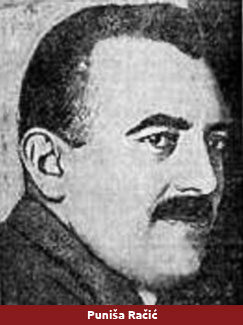 Puniša Račić just
waited for a reason why to act, and
it came with a remark made by Dr.
Ivan Premer he might have not –
eyewitnesses are not quite sure
about it – heard properly and even
less understood. Before starting to
shoot, he said from the rostrum: Puniša Račić just
waited for a reason why to act, and
it came with a remark made by Dr.
Ivan Premer he might have not –
eyewitnesses are not quite sure
about it – heard properly and even
less understood. Before starting to
shoot, he said from the rostrum:
“Ever since I’ve
begun socializing, ever since I’ve
become a man (laughter), I’ve never,
not for a single moment, overlooked
the interests of the Serbian people,
the interests of my homeland.
“I declare before
you all that Serbian interests –
whenever guns and cannons are not
firing – were not more engangered
than today (clamor). And, gentlemen,
when as a Serb and MP I see that my
nation and my homeland are in
jeopardy, I say loud and clear that
I will use some other arms to
protect the interests of Serbhood.
“Our country
should have consolidated itself
several years ago, our people should
have profited from what they
attained in the war with bravery
(emphasis – L.P.) and fidelity to
its allies, while, what’s worst of
all, a part of our people was using
slander to undermine consolidation
and betray the interests of our
people and this country of ours.”20
At this point, Dr.
Ivan Perner interrupted him with a
rather meaningless remark, “You have
robbed beys.” Račić demanded his
punishment from the chair of the
People’s Assembly, or else “I will
punish him myself,” he said. He
threatened all MPs, “Whoever tries
to intervene between me and Perner
will be killed.” And he fired at
Perner. The Chair of the People’s
Assembly just said, “The session is
being adjourned.” Stenographers
noted down, “The session was
adjourned at 11:20 a.m.”21 Here the
transcript ends.
Puniša Račić went
on firing his gun. Dr. Đuro
Basariček was shot dead. Pavle Radić
died in hospital. Josip Granđa who
tried to protect him was wounded: he
died on August 1928 in Zagreb.
Historians have debated whether
Puniša Račić was aiming carefully or
shooting at random. Be it as it may,
Stjepan Radić was his target.
On the basis of
transcripts and reports by its
journalists attending the session,
the Politika daily dedicated almost
an entire issue (June 21, 1928) to
this “historical session.” And then
went on for days to write about the
crime. There were hints at the
murder’s “insanity.” The paper ran a
story about King Alexander visiting
the wounded Radić in the hospital.
Their conversation, according to the
paper, was as follows: the King – “I
came to see you.” Radić – “Thank
you, thank you very much!” and then
he kissed his hand. However, judging
by the statement for the court he
gave 14 days before he died, Radić
told the truth as he saw it: “All in
all, I am convinced that Puniša
Račić was just an executioner of
what had been planned and agreed on
by a part of Radicals’ caucus, and
probably with the knowledge and
maybe the approval of parliamentary
chair Dr. Ninko Perić and Prime
Minister Velja Vukićević.“22 Radić’s
statement led to Minister of the
Court Dragomir Janković and its
highest noblemen. Croatia was imbued
with this feeling. Three hundred
thousand people attended his
funeral, and this mass attendance
“had the significance of a strong,
anti-Serb, anti-governmental and
anti-regime manifestation.”23
After assassination: the hero left
down and the murdered privileged
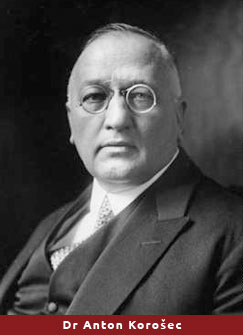 Having committed
the murder, Puniša Račić passed
through ministerial chambers onto
the street exclaiming, “Long live
Serbia, long live Greater Serbia!”
His friend Dragomir Bojović, the
accomplice, had been waiting for him
in a car. Where he had stayed before
giving himself up remains
disputable: was it in some apartment
or in a military facility. In the
afternoon he went to see Minister of
the Interior Anton Korošec. Refusing
to receive him as he was not an
executive officer, Korošec had him
sent to the City Hall. Having committed
the murder, Puniša Račić passed
through ministerial chambers onto
the street exclaiming, “Long live
Serbia, long live Greater Serbia!”
His friend Dragomir Bojović, the
accomplice, had been waiting for him
in a car. Where he had stayed before
giving himself up remains
disputable: was it in some apartment
or in a military facility. In the
afternoon he went to see Minister of
the Interior Anton Korošec. Refusing
to receive him as he was not an
executive officer, Korošec had him
sent to the City Hall.
Puniša Račić was
self-confident: he did not realize
that he was nothing but an
instrument of the crime.
Belgrade-seated „Reč“/Word/paper
described (June 23, 1928h) how first
meeting with reporters, with him
already in jail, looked like.
“A coached
stopped… Puniša came out and nobody
would say he looked like a murderer.
Puniša stepped out, clean shaven, in
brand new, lilac suit, with a new
straw hat on his head and wearing
brown shoes. Not a trace of
anxiousness. When he saw
photographers about to take his
picture, he addressed them smiling,
‘Wait till I stand still and then
take a shot.’ And he stepped at the
first flight of stairs and looked
into the camera peacefully and with
a smile. Everyone was surprised by
the murder’s looks, everybody having
expected to see him brought in
handcuffed.”
Račić felt assured
that his mission had been grand. Why
shouldn’t he when he had been
supported by the circle closest to
the Court, his party, the
parliamentary chair and the Prime
Minister? He was looking forward to
recognition and glory. And then he
turned out to be just a murderer
under protection. His trial was a
farce. Contrary to the law, the
Minister of Justice appointed the
investigative judge. This
predetermined the course of the
proceedings. This was why most of
Belgrade’s lawyers refused to
represent the defense. Stjepan
Radić’s family and party boycotted
the process. The attempt to engage
some French lawyers failed. And it
was the US charge d’affaires in
Belgrade who poked a “probe” into
the process – or in the mentality
and political culture. He wrote in
his report to the Secretary of State
(June 15, 1929):
“To an observer
from the West the way in which this
trial is being handled is
disgusting. Using a less harsh term
would be hard indeed, since all the
motions, from the beginning to the
end, have been marked by deficiency
of dignity for which the President
of the court is responsible beyond
any doubt, and which was often
ridiculed and made a laughing-stock
by both the accused and the audience
of some twenty-odd lawyers and about
the same number of reporters. So,
when a Serb MP was describing
jokingly how his colleagues (but not
him) had rushed to hide themselves
under benches the moment the
shooting started, the audience was
cheering openly at such
inappropriate remarks.”
The American
diplomat goes on, “It is sad to note
that in a case like this one the
murder himself, Račić, was pushy and
manifested no remorse throught the
trial, since he, shooting off his
mouth, took up the role of a patriot
attacked by rebellious elements who
were allegedly after his personal
honor. It is even sadder to note
that several Serbian MPs and one
ex-minister tried to justify the
murder’s act by saying Račić had
acted in self-defense…There can be
no doubt that this inappropriate fun
and frolic must have resounded like
sacrilege to several millions of
Croats who had looked upon Stjepan
Radić, and ubiased observers have
been left under general impression
that effect of these unfortunate
actions could not but be contrary to
better understanding between Western
and Eastern parts of this
Kingdom…And still, this Embassy is
not of the opinion that anyone else
except for Račić himself is truly
responsible for this gruesome
murder, but there is also no doubt
that the manner in which the trial
was handled … strengthened the
standing of anti-Serbian leaders in
Croat masses…I am aftraid this trial
will come down in history as one of
most deplorable cause célèbre in the
history.”
The
above-mentioned report also quotes,
“It is generally thought in Belgrade
that Račić will not serve his entire
sentence (20 years – L.P.) but
could, in fact, be included in
various amnesties the Crown has been
proclaiming from time to time.”24 Such
forecasts turned out to be basically
correct – and actual developments
even more favorable to Puniša Račić.
Out of the 20-year
imprisonment, Račić spent twelve
years in a villa near the Zabela
prison in Požarevac. He had even
moved his family to Požarevac. His
wife was receiving 3,000 dinars from
the Foreign Ministry’s disposition
fund each month. He owned a coach of
his own.
He was formally
released during occupation and the
quisling regime. He moved back to
Belgrade. There are several versions
of way his life ended. According to
one, he went to a mill at the foot
of the Mt. Avala. A partisan unit
tracked him down and shot him dead.
|